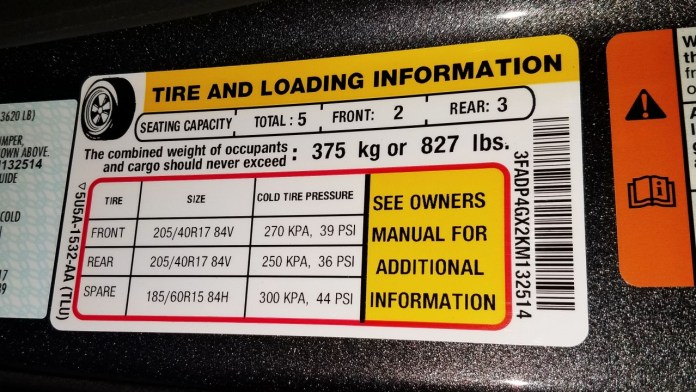Don’t know where to find the answer to the question what should my tire pressure be? You’re not alone! Many drivers aren’t sure which tire pressures they should use, or why it even matters. Finding the right tire pressure can be confusing, and that’s why we are here to help lead you in the right direction. Read on to learn more about proper tire inflation levels and why this is an important factor for safe driving.
How Do I Find the Correct Tire Pressure for My Car?
The recommended tire pressure for most passenger cars typically falls within the range of 32 psi to 35 psi when the tires are cold. To ensure the most accurate reading, it’s best to check the pressure after the car has been sitting overnight or parked for a few hours.
Where Can I Find The Recommended Tire Pressure For My Car?
You can typically find the recommended pressure listed on a sticker inside the driver’s door or in the owner’s manual.
What Happens if I Don’t Keep My Tire Pressure at the Right Level?

Under-inflated tires can be dangerous to drive on, as they increase the risk of a tire blowout or skid. Under-inflation also reduces fuel efficiency and increases wear and tear on your car’s suspension. Over-inflation can cause the tire to lose contact with the road surface, making it hard to control your vehicle when cornering or braking. Keeping your tires properly inflated is important for both safety and optimal performance.
Can Improper Tire Pressure Cause Uneven Tire Wear?
Improper tire pressure can lead to uneven wear on your tires, which can result in needing to replace them sooner than expected. If you notice that the center of your tire tread is more worn than the sides, it’s a sign of over-inflation. If the opposite is true and the sides have more wear than the center, it’s likely under-inflation.
How Does Temperature Variation Affect Tire Pressure?
While colder weather can cause PSI to drop, excessive heat can cause your tire pressure to temporarily increase. Keep in mind, for every 10 degrees of increased temperature, your tires can be expected to increase by 1-2 pounds of pressure.
What tire pressure is recommended for winter driving?
Experts generally recommend a tire pressure of 34 to 38 PSI for winter temperatures, but it’s important to note that this may vary based on the make and model of your vehicle and how low the temperature drops. It’s always best to consult your owner’s manual for exact specifications.
What tire pressure is recommended for summer driving?
Summer temperatures can cause your tire pressure to increase, so it’s best to adjust your tires accordingly. The ideal range for summer driving is typically between 30-35 psi when the tires are cold.

How Often Should I Check My Tire Pressure?
It’s recommended that you check your tire pressure once a month. With regular use, tire pressure tends to decrease over time due to air leakage, so it’s important to watch the pressure closely. It’s also a good idea to check your tire pressure before any long trips or if you feel excessive vibration while driving.
FAQs about What Should My Tire Pressure Be
What PSI should normal tires be?
The ideal tire pressure for most passenger cars typically falls within the range of 32 psi to 35 psi when the tires are cold. To ensure the most accurate reading, it’s best to check the pressure after the car has been sitting overnight or parked for a few hours.
Is 40 psi too high for tires?
If your recommended psi is 35 and the maximum safe pressure is 44 psi, putting in 38 or 40 psi is safe.
Can low tire pressure cause an accident?
According to the National Highway Traffic Safety Administration, around 11,000 tire-related crashes occur annually, with many of these being caused by underinflation. Under-inflated tires can be dangerous to drive on, as they increase the risk of a tire blowout or skid.
What should my tire pressure be if I’m carrying extra weight?
In most cases, the recommended tire pressure is 40 psi, which is more than sufficient for most vehicles. However, if you’re heavily loaded, you may need to consider increasing the pressure to up to 44 psi.
How much does tire pressure drop when cold?
The amount of air pressure lost due to cold temperatures can vary, but generally it is safe to assume that tire pressure will decrease by 1-2 psi for every 10 degree drop in temperature.
Does tire pressure have to be exact?
While it’s important to keep your tires inflated within the manufacturer’s recommended range, you don’t need to aim for an exact number. The most important thing is to check the pressure regularly and make sure it’s not too high or too low. Over-inflation can be just as dangerous as under-inflation, so always err on the side of caution.
Conclusion
Keeping your car’s tires at the right pressure is important for a safe, efficient and comfortable ride. Take the time to check the recommended tire pressure for your vehicle and make sure that you’re keeping up with regular maintenance by checking your tire pressure often. With proper care and maintenance, you can ensure that your tires are performing optimally and safely. Thank you for reading! We hope this article was helpful in answering the question what should my tire pressure be.

I’m Timothy Ballard, owner of a used car dealership in Springfield. I love just about everything automotive, but I have a special place in my heart for trucks. I’m an ASE Certified Master Technician, so I know my way around a car. In my spare time, I enjoy traveling with my family and hiking new trails.
